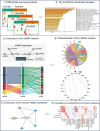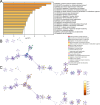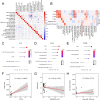Comprehensive characterization of the competitive endogenous RNA network revealing its immune-related functions in hepatic ischemia-reperfusion injury
- PMID: 40705804
- PMCID: PMC12289005
- DOI: 10.1371/journal.pone.0327101
Comprehensive characterization of the competitive endogenous RNA network revealing its immune-related functions in hepatic ischemia-reperfusion injury
Abstract
Hepatic ischemia-reperfusion injury (HIRI) is a common complication in liver surgery and transplantation. Recent studies have revealed the significant role of the competing endogenous RNA (ceRNA) network in HIRI. Herein, we comprehensively analyzed the HIRI-related ceRNA network and its correlation with immune-related pathways and immune cells in HIRI patients. We identified 449 lncRNAs, 26 miRNAs, and 548 mRNAs differentially expressed in HIRI patients. We constructed a HIRI-related ceRNA network in liver transplant patients consisting of 3 lncRNAs, 3 miRNAs, and 29 mRNAs. Biological function analysis showed that the HIRI-related ceRNA network contributes to HIRI progression by regulating calcium ion-related regulatory pathways and processes. An immune-related ceRNA subnetwork, which consists of 1 lncRNA (PARD6G-AS1), 1 miRNA (hsa-miRNA-125b-5p), and 4 mRNAs (PLAU, CCR5, FGF5 and IL24) was obtained. The immune-related ceRNA subnetwork was significantly related to the immune-related pathways and immune cell infiltration. The PARD6G-AS1/miR-125b-5p/IL24 axis was identified as a potential ceRNA sponge that may influence NK cell activity in HIRI. Our results underlined that the lncRNA-miRNA-mRNA ceRNA network can positively or negatively regulate immune-related functions and infiltrating immune cells mediated HIRI, which could provide further insight into novel molecular therapeutic targets.
Copyright: © 2025 Liu et al. This is an open access article distributed under the terms of the Creative Commons Attribution License, which permits unrestricted use, distribution, and reproduction in any medium, provided the original author and source are credited.
Conflict of interest statement
The authors declare that the research was conducted in the absence of any commercial or financial relationships that could be construed as a potential conflict of interest.
Figures






Similar articles
-
Construction of an immune-related prognostic signature and lncRNA-miRNA-mRNA ceRNA network in acute myeloid leukemia.J Leukoc Biol. 2024 Jun 28;116(1):146-165. doi: 10.1093/jleuko/qiae041. J Leukoc Biol. 2024. PMID: 38393298
-
Bioinformatics analysis of immune infiltration in human diabetic retinopathy and identification of immune-related hub genes and their ceRNA networks.Sci Rep. 2024 Oct 14;14(1):24003. doi: 10.1038/s41598-024-75055-3. Sci Rep. 2024. PMID: 39402134 Free PMC article.
-
Identification and Characterization of a ceRNA Regulatory Network Involving LINC00482 and PRRC2B in Peripheral Blood Mononuclear Cells: Implications for COPD Pathogenesis and Diagnosis.Int J Chron Obstruct Pulmon Dis. 2024 Feb 8;19:419-430. doi: 10.2147/COPD.S437046. eCollection 2024. Int J Chron Obstruct Pulmon Dis. 2024. PMID: 38348310 Free PMC article.
-
Multifaceted interactions between lncRNA-associated ceRNA networks and small molecules in triple-negative breast cancer.Biomed Pharmacother. 2025 Aug;189:118241. doi: 10.1016/j.biopha.2025.118241. Epub 2025 Jun 16. Biomed Pharmacother. 2025. PMID: 40527037 Review.
-
Research progress of lncRNA and miRNA in hepatic ischemia-reperfusion injury.Hepatobiliary Pancreat Dis Int. 2023 Feb;22(1):45-53. doi: 10.1016/j.hbpd.2022.07.008. Epub 2022 Jul 30. Hepatobiliary Pancreat Dis Int. 2023. PMID: 35934611 Review.
References
MeSH terms
Substances
LinkOut - more resources
Full Text Sources

